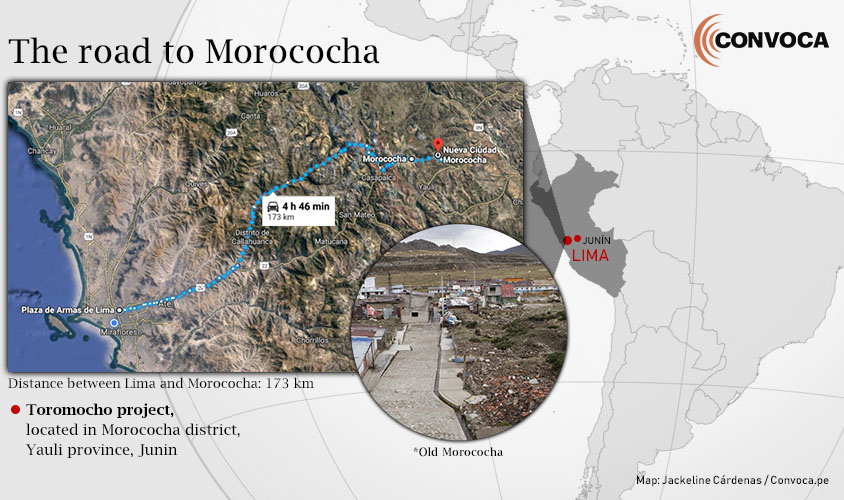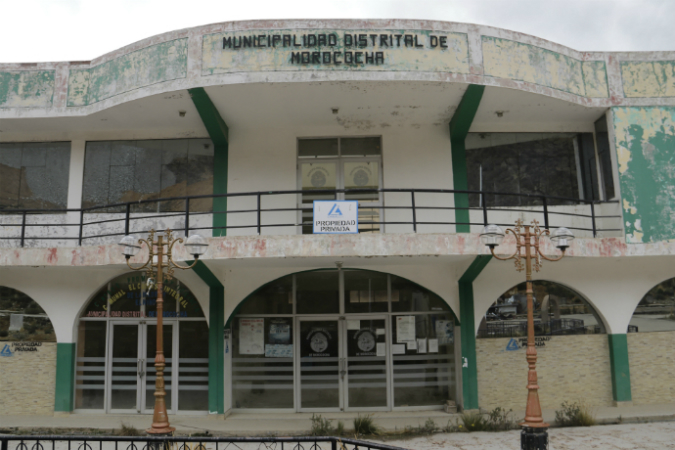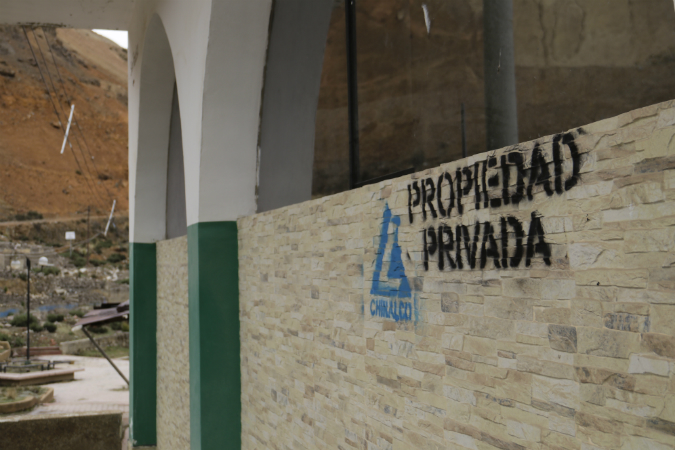Mining giant Chinalco, which operates the Toromocho Project in Peru, built a town to resettle the population of Morococha to enable the extraction of copper from beneath the ground where some 5,000 people once lived. Six years after the beginning of the move – once celebrated as a triumph in community relations – the new settlement has no economic future and is fast becoming a ghost town.
Diálogo Chino and Convoca.pe travelled to the area five hours from Lima, discovering that amidst the frustration of the resettled population, there is another social conflict. The last inhabitants of the old town have refused to relocate and are being dispossessed of their land. They find themselves in an increasingly precarious situation.
By Gonzalo Torrico / Special envoy to Morococha
Translation: Diálogo Chino
Publicado el 5 de diciembre del 2018
In the chilly mountains of Peru’s central highlands, more than 4,700 metres above sea level, the demands of the last inhabitants of Old Morococha – 65 families who resist resettlement – hang frozen in the air. For the past six years, they have been living with the tremors, dust and noise of detonations at the Toromocho mine, operated by Chinese company Chinalco, which has invested US$4.476 billion in the megaproject.
Heavy machinery has now almost completely razed all buildings in the village. The rubble resembles a war zone. In this area of Peru prone to natural disasters, the world’s second largest producer of copper, Chinalco wants to create an open-pit to exploit minerals beneath Morococha. Until 2012, it was home to more than 5,000 residents. 96% have left the site. Several more have settled in a new town built by Chinalco some 12 kilometres away.
In Old Morococha, those remaining live in difficult conditions, themselves protagonists in an ongoing social conflict. The mine, 160 kilometres from the capital Lima and one of Peru’s largest copper projects, is slated for a US$1.355 billion expansion.

Los antiguos espacios públicos están abandonados y destruidos. Foto: Marco Alegre/Convoca
“It is sad to live here. There is no business here. There is nothing,” Feliza Alania, one of the last inhabitants of the old town, says tearfully from her gloomy grocery store. She says she used to sell an average of US$45 in goods each day. Now, only her own family consumes what’s left on the dusty shelves.
Chinalco has tried to negotiate a deal with the remaining residents, who are adamant they won’t accept the same conditions the transnational company offered their former neighbours. “They have offered us crumbs, I tell you,” said Máximo Díaz, a carpenter and Alania’s husband. Díaz is also the President of the Broad Front for the Defense and Development of the Interests of Morococha (FADDIM), a collective founded following the resettlement process.
The company did not recognise the residents’ right of land ownership at the time of their purchase offer, according to Noé Gamarra, a representative of displaced former property owners. He explains that Chinalco has only given quotes for the value of the erected buildings, but not for the land. Under this criteria, he says, market prices average between US$60 and US$100 per square metre. Yet this does not take into account minerals in the subsoil, especially copper. Extracting it could increase the mine’s daily output from 117,000 to 172,000 metric tonnes.
Chinalco expects to reach this capacity by 2020 when the expansion of the Toromocho Project, which the Ministry of Energy and Mines of Peru approved on March 23 this year, is complete. That same day, then vice-president Martín Vizcarra assumed the Peruvian presidency in the midst of a deep political crisis that led to Pedro Pablo Kuczynski to resign.
In June, in the presence of Vizcarra himself, Chinalco announced the beginning of expansion works. “When investment represents progress and development, the State becomes an ally in that investment,” the President said. After the expansion, the project is expected to generate US$2 billion annually.
However, the company will only meet this target with no one on the land the mining giant wants.

El presidente peruano Martín Vizcarra y Ge Honglin, actual presidente de Chinalco, anuncian la ampliación de Toromocho en junio de 2018. Foto: Andina.
“If they do not reach [an agreement] with me, they must let me live in peace,” says Díaz defiantly. “The blasts from the mine shake like an earthquake and twice the roof of my workshop has been damaged [by falling rocks],” he says. Such occurrences are commonplace.
Huang insisted the needs of the people of Morococha would be a priority: “We consider it necessary to show the sense of responsibility of our company and to achieve a synergistic development between the economy and the local communities, in line with our motto: first contribute to the development of the local communities, then think about bringing the project to fruition.”

Máximo Díaz, 66 años, preside el Frente Amplio de Defensa de los Intereses de Morococha. Foto: Marco Alegre/Convoca.
Trust has eroded between the population, law enforcement and the authorities. Elvis Atachahua, a resident of Morococha, claims police officers travel in vehicles contracted by the mining company and support Chinalco’s demolitions which, he says, don’t have municipal authorisation. In the past, the Special Operations Division of the National Police and the Chinese state-owned company had an agreement acknowledging the company’s privileges. Inhabitants seem unequal before the law in Old Morococha.
For its part, Chinalco has, with some success, presented itself to the world as a company with a strong sense of social responsibility. No wonder, Toromocho is very important for the Aluminum Corporation of China, Chinalco’s parent company, given the enormous copper deposits and the amount of the rusty red metal China demands. The mine’s reserves are estimated at 1,526 million tonnes. In the first half of 2018, Peruvian copper exports were worth US$7,696 million, according to the National Society of Mining and Petroleum. 61% of shipments of this metal were China-bound.
“As everyone knows, copper minerals are scarce in China,” Huang Shanfu, then President of Chinalco in Peru said in an interview with Chinese state-run station CCTV on 13 November 2016. “As this project [Toromocho] gets underway, a solid basis for guaranteeing China’s copper resources will gradually be consolidated,” he stated. Other Chinese media, such as Sina News Finance this year questioned the economic wisdom of expanding the mine in the face of falling ore prices and company losses. News bulletins about Toromocho on Chinalco’s website have not been updated since 2013.
Pero Huang Shanfu también insistió en priorizar las necesidades de la población de Morococha: “Consideramos necesario poner de manifiesto el sentido de responsabilidad de nuestra empresa y lograr un desarrollo sinérgico entre la economía y las comunidades locales en sintonía con nuestro lema: primero contribuir al desarrollo de las comunidades locales, después pensar en la realización del proyecto”.

Chinalco ha invertido 4 476 millones de dólares en el proyecto Toromocho. La ampliación costará 1 355 millones de dólares más. Opera a cielo abierto. Foto: Chinalco.
However, residents’ anger towards the company is palpable. “[Do you know] how many times they have tried to get me out of my house!” Edelmira Artica, whose residence has Chinalco’s logo stamped on the front, says heatedly. “Their guards know what time we enter and what time we leave (...) Even his lawyer has said to him: ‘You have already lost your house down there [in the new city]; you have no right to anything’. I cannot eat my house – what we want is work! With work, I can do better than that house. But all the work avenues are closed off,” he laments.
In Morococha, if you are ‘lucky’ enough to have a job, you have to protect it. “From the day Chinalco arrived, all work is subject to conditions. Once [the term of] your contract is complete, they no longer wish to renew it,” says Rolando Jerónimo, another resident.





